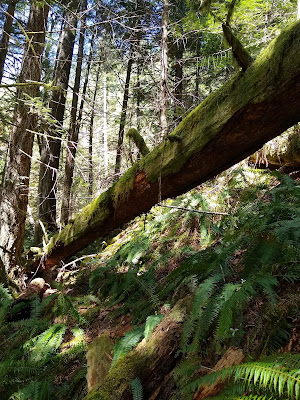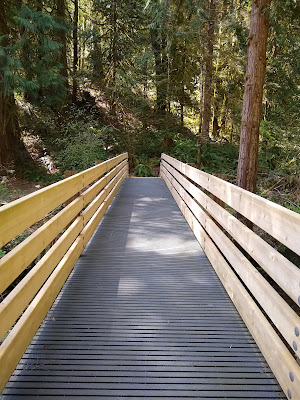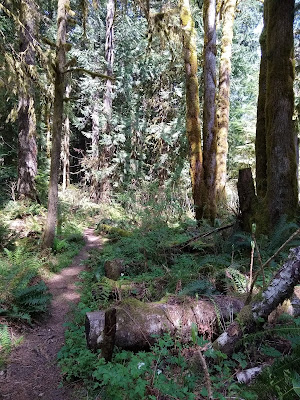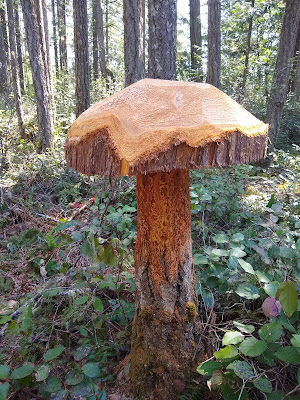When I was a kid, growing up in California and Utah, I quickly learned to hate going on hikes.
And today I took a hike -- and loved it.
Frankly, if you'd told 2015 me that I would eventually choose to hike, of my own volition, without a gun to my back, I would have laughed and told you to up your dosage. But I'm starting to come around for a number of reasons.Last week I had the pleasure of dogsitting a very good and well-behaved boy named Eddie. When family is away, sticking to a pet's everyday schedule helps foster a feeling of calm and reassurance, so I made sure to take Eddie on his usual twice-daily walks. While there were a few times when it felt like he was dragging me up and down hills at the end of a leash, most of the time I didn't have trouble keeping up with him. And when I took him to off-leash parks, I didn't even have to do that -- he could snuff around in the underbrush looking for squirrels to harass, and I could walk along the trail nearby, keeping an eye on him without having to run to catch up. It didn't feel difficult because I had plenty of chances to stop and rest, and it was genuinely pleasant walking in the woods and along the beaches of Puget Sound. So at the end of the first day, I was shocked to discover that I'd hit my 10,000 daily step goal for the first time since the thoroughly exhausting day we packed up and moved out of our Redmond house. Because of those daily walks, I continued to meet or exceed that goal pretty much effortlessly every day I took care of Eddie. I wasn't even waking up sore the next morning.Once I returned home, I did a little thinking and realized I didn't have to take Eddie with me to achieve that step goal (or at least get close to it), as long as I was willing to find a local park, beach, or trail and do the walking on my own.
So why is this a big deal?Well, today I realized that I still do hate hikes, but -- and this is the big breakthrough -- only specific KINDS of hikes. I hated the double-digit-miles, strenuous group hikes that were part of my childhood in both the Camp Fire Girls and the church-sponsored camping trips for young women. Such hikes were usually conducted during the hottest part of the day, so we'd have to carry metal canteens with us, which were heavy, unwieldy, clanked against our hip bones and often leaked all over our clothes. The fastest hikers in the group were usually allowed to set the pace, which meant that the slowest of us (it meeee) never got a breather. The folks in front were told to stop every now and then to rest and let the slower hikers catch up, but as soon as the last person caught up with the group, everyone would immediately start off again. (And the unspoken idea among the adult leaders, I think, was that the slower hikers could stand to lose some weight anyway, so why should they get a break?) The parts of California and Utah where I grew up were arid, with little shade along the average hike, meaning that it was a deeply uncomfortable experience for anyone who was slow, fat, and sweated heavily. These hikes sucked all the fun out of the experience for me, and the minute I could avoid them, I stopped going.
This was a shame, because there were many things about nature hikes that I loved. I loved coming across small creatures in their own habitats. I loved seeing all the different plants growing and the spicy smell of the red earth and the graceful shape and movement of the trees. And, frankly, I often made no effort to catch up with the group because I liked taking things at my own pace and enjoyed feeling like I was alone in nature. Today it occurred to me that if I hiked by myself, I wouldn't have to worry about keeping up with the group because there wouldn't be one. I wouldn't have to worry about getting sweaty and muggy because this is the Pacific Northwest and even in the heat of the day, there's plentiful shade from large trees on most hiking trails. I wouldn't even have to carry water with me on the short trails; I could tackle them without getting dehydrated. And although I'm still obese, I weigh about 100 pounds less than I did a decade ago, so moving my body isn't as difficult or painful as it was back then. Further, because every trail and park and beach and green space on this peninsula is new to me, it feels like an adventure to be exploring each one for the first time. It feels like I could be going anywhere. And that's the thing I enjoyed most about hiking when I was a child: that sense of adventure, of stepping into unknown territory, what I would later call liminal space, where anything could happen. I had the trail all to myself today. Literally, I didn't see another human being on the entire hike. In fact, the trail was infrequently traversed enough that I kept having to hold my hand up in front of me so I didn't accidentally walk face-first into a spiderweb crisscrossing the space.At one point a little garter snake crossed my path. He slipped away as quickly as he could, so I didn't take his picture, but he was a beautiful deep brown with lengthwise yellow bands.
Seeing a lot of these plants put me in mind of Stephan Seable. When I was growing up in California, he taught us kids about which local plants were safe and good to eat. I recognized a few of these, things like fiddleheads and so forth, but for the most part everything was new to me. Oh hey, wild bleeding hearts! As I continued down the trail I began to hear the sound of running water, which always makes my heart happy. But the original trail bridge over the creek (as seen here) was permanently closed. So instead I took this one! Built like (and possibly by) a truck! I made like a Billy Goat Gruff and trip-trapped over this thing in no time. Made it to the big tree after which the trail is named (in this case, it's a Douglas fir), and it is indeed big. While I have seen larger trees in Big Trees State Park and in Sequoia National Park in California, the difference is that this tree is notably larger than all the other trees around it. It is singular. Sat for a while on the flip-top bench near the big tree and just listened to the creek running by. There were a few birds piping in the trees, the sound of what was probably a diurnal owl, squirrels chittering at each other, and probably if I waited there long enough another snake (or the same snake) would show up. A single white butterfly floated around the ferns and bracken. It occurred to me that it's been a long time since I've seen a butterfly in the wild. 50-odd years ago when I was little, you could find monarch caterpillars and butterflies everywhere there was open space and milkweed growing. But now a lot of those open spaces have been plowed over and turned into houses and condominiums, and no one grows milkweed. So a lot of the places where the monarchs used to grow up are gone. These days if you choose to plant milkweed in your yard there's a good chance you will become part of the monarchs' migration path every year, because there is so little wild space left for them to exist in. This forest was exactly the kind I would have adored when I was a child. Frankly, I still do. It felt like the kind of spot a fairy tale would take place in. You could easily imagine a slightly anthropomorphic wolf stepping from behind a tree to convince a little girl to pick trilliums by the side of the path. Or a hollow tree where six princes in exile are living, until such time as it is safe for them to return to their kingdom. Or maybe some kind of forest wizard. Perhaps a nixy might rise up out of the water and offer a challenge or request a favor. Or, you know, you could even find Piglet's house. That's what liminal spaces are -- places where the unlikely or the unusual are much more willing to happen. A liminal space is a place that humans have not yet pegged down, squared off, and gentrified in some way. Or it's a place that refuses to be tamed. It's where the human notions of cause and effect, of what they expect to happen, do not apply. I realize that going on a hike by oneself is potentially dangerous. (At the time I write this, actor Julian Sands is missing and presumed dead after having gone on a hike alone in midwinter.) But the advantage to hiking solo in a relatively safe place is that you can walk at the best pace for you. If you're heading up along a steep switchback and you feel tired, you can stop and rest until you're ready to continue, and no one will be tapping a foot or looking meaningfully at a watch. If you want to take a closer look at a tree, a flower, a bush, a spiderweb, a squirrel, a snake, or even a cougar from a safe distance, you can stop and take all the time you need. (It's probably worth noting that even though this is cougar territory, I'm not particularly afraid of meeting one out here. Cougars are not highly aggressive toward humans; they tend to be far more scared of us than we are of them.) At the top of the trailhead there were several human-made artworks, most attempting to bring some whimsy or magical quality to the area. But honestly, they didn't hold a candle to the real thing. I'll be looking for more trails around here very soon.



































No comments:
Post a Comment